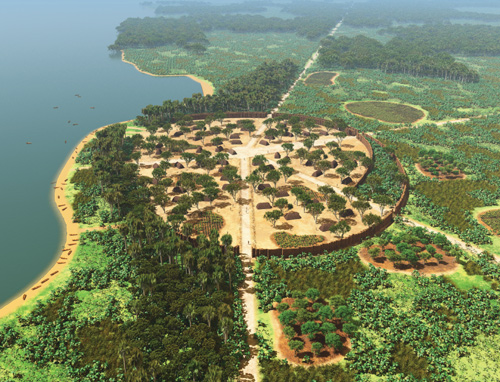Tombs of Pre-Inca Elite Discovered Under Peru Pyramid
Kelly Hearn in Buenos Aires, Argentina
for National Geographic News
November 27, 2006
A complex of tombs recently discovered under a pyramid in Peru offers
landmark clues to a thousand-year-old pre-Incan culture,
archaeologists report.
Among the findings are meticulously arranged human remains; gold,
gilt copper, and bronze artifacts; and the first decorated tumi, or
ceremonial knives, ever discovered by archaeologists at a burial site.
The graves belong to elite members of the Middle Sican culture, a
gold-working people whose farming culture thrived in Peru’s desert
coastal region from around A.D. 900 to 1100.
Shimada and colleague Carlos Elera Arevalo, director of Peru’s Sican
National Museum, say the discovery is yielding crucial clues to this
ancient civilization.
“What is most important about our fieldwork is we found an intact pre-
Hispanic elite cemetery,” Shimada said in an email interview.
The tombs formed a kind of religious complex that had managed to
escape looters who commonly pillage burial sites throughout Peru.
Shimada said finding these rare objects undisturbed can help
researchers “divine the context in which ceremonial items were used.”
Ceremonial Knives
A key find involved 12 ceremonial tumi knives. Eight of the knives
were plain, four were decorated, and two bore the likeness of the
Sican Deity, believed by Sicans to rule the supernatural world.
Archaeologists have previously found undecorated tumi knives in
residential and ceremonial settings. But until now they had never
excavated ceremonial knives bearing “ideologically charged
representations of the Sican Deity,” Shimada said.
Until this discovery, Shimada added, the only decorated knives that
archaeologists could study were those taken from tomb raiders.
“For decades the tumi knife bearing an image of the Sican Deity has
been a national symbol of Peru,” Shimada said.
“Yet thus far all known tumi knives with such a representation had
been illegally looted, and little was known of their cultural contexts.”
Shimada said some scholars believe the deity on the knives to be
Naylamp, a figure who, according to an oral history recorded by
Spaniards in the 16th century, became a god after emerging from the sea.
Peruvian Pyramid
Shimada said it is particularly important that the tomb complex was
found beneath a pyramidal temple mound known as Huaca Loro.
“Many pre-Hispanic tombs were placed in existing mounds, but this is
the first time that a major cemetery was found underlying a major
mound,” he said.
The artifacts and elements of the tombs’ layout suggest that the
Sican had a deep reverence for ancestors and that the people had
apparently made repeated pilgrimages to the site.
“The fact that people had come at least 20 times over 500 years to
leave offerings and burn the ground around the cemetery indicates the
intimate and persistent relations between local populations and their
ancestors,” according to the project summary.
Shimada said the team found a “seated adult male personage wearing a
copper-silver crown, decorated tumi knives, a gilt copper ceremonial
cup, a large pectoral made of a gilt copper disk, and turquoise,
shell, and other beads.”
The man was found in a small square tomb 23 feet (7 meters) below the
modern ground surface. He had been buried facing east toward a tomb
believed to house one of the Sican’s dynastic founders. “We also
documented a number of large tombs of female elites that suggest that
they played important social and religious roles in the Middle Sican
culture,” Shimada said.
One woman in her 20s was found sitting cross-legged in a 11.5-foot-
square (3.5-meter-square) shaft tomb 33 feet (10 meters) below the
surface.
Her body was surrounded by painted cloths and flanked by ceramic
vessels, cast bronze artifacts, and a ceremonial cup of copper-silver
alloy, he said.
“Overwhelmingly Important” Find
Joanne Pillsbury, director of pre-Columbian studies at the Dumbarton
Oaks Research Library in Washington, D.C., said the discovery was
“very exciting” and that she expected it to generate “important new
data on this complex pre-Inca culture.
“This excavation is a rare opportunity to examine the contents of an
intricate burial,” she said.
She added that Shimada will likely produce insights into ancient
health and cultural affiliations by analyzing skeletal materials
found at the site.
Walter Alva, a Peruvian anthropologist, has also praised the
discovery, telling the Associated Press it was “overwhelmingly
important.”
Shimada has received funding in the past from the National Geographic
Society’s Committee for Research and Exploration, including the
excavation of a Middle Sican pottery workshop in 2001.
National Geographic News is a division of the National Geographic
Society.

